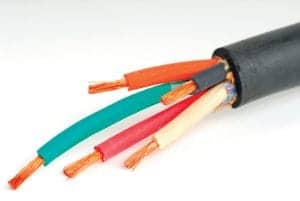The vendor has been all over that system—twice. They can’t find anything!”
“This is the third power supply in 3 months.”
“It’s a lemon. Put a new one on budget request.”
“It just crashes—I don’t know why.”
“One-and-a-half days to recover function. Why?”
“That overrated scanner is a piece of junk!”
You’ve got a problem, but you can’t find it. The experts have scoured your system and cannot find the problem, and that in itself is a symptom. It is a matter of focus. A system expert is trained to look exhaustively inside the system for the problem. Usually, you are faced with shrugged shoulders or a vague reference to, “It could be a power problem.” At this point, you have the problem—because power is a facility issue and it is your facility. Sometimes, you have to call time-out and go to power troubleshooting when experts are stumped. Now what do you do?
The biomed community is trained in some of the most advanced technology in the world, but has historically ignored the basic technology that provides the motive force beneath the wizardry. Welcome to the wall outlet, the power panel, and the world of arc flash suits and the guys who wear them. The industry calls it “power quality.” The basics of power quality will not make you an electrical engineer, but it will open a whole area of troubleshooting that has been hidden behind a locked door covered with electrical warning signs.
We expect that electrical power is “as advertised.” Proper voltage: check. Frequency: check. Sinusoidal waveform: check. Consistent, always there, boring: check. The reality is a bucket of ice water dumped on your head. Modern medical technology is being deployed on a facility platform built in the last century. These electrical systems, when new, were never meant to support today’s complex technology and the network of computers that tie it all together in a fine-grained patient image/data machine. These dated facility systems now have many decades of wear and tear and budget-deferred maintenance.
Is power quality the root cause of your problem? A rule of thumb that works for me is that you take the age of the facility—for example, 20 years—divide that in half, and convert it to a percentage—in this case, 10%. That is an estimated percentage of equipment problems caused by power quality in your 20-year-old facility. Short of having a power quality electrical engineer on staff (which is not a bad idea), what is a biomed to do? The good news is that a structured troubleshooting approach using the appropriate tools can get an economical solution in place.
The Case of the CT with the 600 Ohm Ground
Personal story: “Dave, the CT can’t get through a flow study without quitting in the middle. They’ve tried everything. They can’t find the problem. They are ready to scrap the CT. See what you can come up with.”
A flow study traces the flow of a big bolus of contrast through selected areas of the patient’s circulatory system. The bolus is injected, and about 40 CT slices are exposed to follow the flow before the contrast is diluted in the blood. You get one chance. If the continuous exposure is interrupted, the patient has to wait another day for the contrast to dissipate before the process can be repeated, along with another dose of CT radiation.
Normally, the brand of CT in question had a reputation for high reliability. I talked with the CT tech. He said it reminded him of another CT that turned out to have a power problem. I have learned to pay close attention to the instincts of imaging techs. They are sharp observers.
First step, I haul out my new clamp-on ground tester to check the system ground at facility power entry to the CT. A half-ohm was normal. I measured 600 ohms. Recheck everything. Reclamp. Six hundred ohms?! The source of the 600 ohms was found weeks later by a contractor in a locked closet in a panel with an improvised electrical disaster (IED) that was supposed to achieve the conversion from 4-wire Delta 3-phase power to the European 5-wire Wye power on the cheap. Thirty thousand dollars later, after an electrical contractor installed an isolation/conversion transformer and a high-quality 3-phase surge suppressor, and various charred bits in the CT power distribution cabinet were replaced, our million-dollar asset’s reputation for reliability was restored. Perfect procedures every time, ever after.

The Gremlins in the Wall
Good power quality is consistent delivery of a target voltage with sufficient current and power in a clean, undistorted sinewave at the target frequency. It is physically delivered over copper wires of adequate thickness from a distribution panel fitted with electrical breakers that act as resettable fuses to interrupt the flow of power when the device draws too much current for the wires to safely carry. The “hot” power wire is color-coded black, the return wire is the white neutral, and the safety/ground is green. Three-phase power has three voltage sinewaves on three hot wires (black, red, and blue). The sinewaves are evenly spaced 120° from one another. This is the friendly Mr. Reddy Kilowatt.
Then there are the gremlins. Bad power quality consists of delivery of voltages consistently too high or too low, intermittently too high or too low (surges and sags), electrical transients (quick bursts of really high voltage—around two to 10 times normal), dropouts (momentary lack of any power at all), power failures (extended lack of power), harmonics (distorted sinewave), noise (unwanted random frequency voltage on the sinewave), and the occasional lightning hit.
Bad power quality can also come from a deteriorated electrical infrastructure. In a 50-year-old building it is common to see loose wires, undersized wires, intermittent breakers, undersized breakers, contactors with sticky or resistive contacts, incorrectly tapped transformers, panels or circuits not labeled or incorrectly labeled, sensitive equipment wired on the same circuits as high amp-draw elevator and air conditioner loads, loose wires, bad emergency generator phase matching, improperly managed computerized electrical load management, unbalanced phases (three-phase equipment), broken or loose outlet receptacles, harmonics, lack of proper isolation transformers (see “CT” above), miswires, loose wire connections, undersized grounds, conduit grounds, and loose wires. Did I mention loose wires?
VIPs
If you are going to investigate power quality problems, you are going to need some important people. The first person will be an electrician who knows the territory. This is the guy who is going to provide access to the electrical system, knows the architecture of the system, and who can keep your investigations safe for you personally and the equipment connected to the system. My favorite electrician is an ex-‘Nam tunnel rat who knows every wire on our huge campus and who lives and breathes the electrical trade. I trust not only my equipment, but also my personal safety to him.
The next person is an electrical engineer who is available locally, by telephone, or best—located in the facility. This is the guy who can give advice and theoretical background to assist in troubleshooting and even in specifying a fix. An electrical engineer’s recommendation carries a lot of weight in convincing management to spend scarce resources on a fix that may cost tens of thousands of dollars. Vendors in the power quality field usually know good electrical engineers.
Free Power Quality Tools
When the million-dollar CT was saved from the scrap heap, all of our power quality tools, past, present, and future, were paid for—with money left over. This is typical. Buy good tools. Their monetary leverage is high, so get what you need because they pay for themselves immediately. This is especially true with high-dollar assets like imaging equipment or assets with high critical patient loading. Renting before buying is a good way to try out power quality tools.
Buy tools that are easy to use, have good customer support, and have good report writing and graphical support. Many times, you just “know” that a problem is power-quality related, but the corporate reality demands that someone has to present a reasoned case based on objective evidence to merit resources necessary to find and fix the problem. The analysis and report software packaged with the analyzer is beyond valuable.
Let me stress it again: Work with tools that are easy to use and that produce results that are relatively easy to interpret. Many power quality analyzers are so user unfriendly they require an electrical engineer to hook them up. These wind up in a dusty closet and are never used. Unused tools are beyond useless—they are not saving you money.
The Toolbox
- Documentation: Outlets and switches should be marked according to source panels. Panels should have breakers marked according to destination. The facility engineering office should have “one-line” schematic diagrams of the electrical systems with component and closet locations. These are sometimes called “as built” prints. Documentation requires a lot of maintenance, and sadly, it is often allowed to deteriorate to uselessness. Well-maintained documentation is one of the most valuable electrical tools.
- Outlet Tester: Not the little neon-bulb plug-in outlet polarity tester, but a test device called a “line load simulator” that can indicate the voltage drops on each of the wires and the ground quality by checking instantaneous load. This device can indicate loose connections, undersized wiring, ground quality, and GFCI operation. It virtually eliminates having to pull receptacles apart to look for loose connections. It is also a great point of reference when writing a repair order for the electricians.
- Wire Tracer: Get the best—one that can trace through walls and trace from breaker to outlet and vice versa. This eliminates a lot of hit-or-miss “Easter-egging” while trying to find panels in facilities lacking documentation.
- Clamp-On Ground Resistance Tester: This device works by inducing a 3.3 kHz signal pulse into a ground cable and timing the signal decay. Ground resistance is the first circuit test, and subsequent tests depend on it. The ground has to have a 0.5-ohm impedance or lower. This is important for keeping noise out of circuits, for the proper operation of filters and surge suppressors, and to maintain voltage reference, not to mention electrical safety. The only proper ground for medical equipment or computers is a heavy stranded third wire ground, preferably unbroken all the way to the panel ground. Conduit ground, where the ground conductor is the metal in the conduit pipe and receptacle box, is unsuitable for medical equipment. When you have established that the ground is good, you can proceed to hook up the next piece of test equipment.
- Power Quality Analyzer: Buy one with menus and connection diagrams stored in the memory. I like the rope-like current sensors—they are easier to thread around conductors in a tight panel box. Another feature to look for is the ability to download or look at data without interrupting the monitoring. The analyzer has to be very easy to use and, once purchased, should always be hooked up to some facility circuit. A dedicated laptop for downloading and report generation is necessary at the VA due to security restrictions on the use of USB devices.
- Thermal Imager: An enormously useful tool. In an electrical context, it is the tool for finding bad (hot) connections in power panels and (hot) failing breakers without having to touch high voltage. It has many other uses, such as monitoring air conditioning in server rooms and water cooling of such things as linear accelerators.
Practical Fixes
At Edward Hines VAMC (first buildings erected in 1921), we have used power quality investigations to direct the use of uninterruptible power supplies to bridge power dropouts, to clean up unacceptable power quality, and to specify use of highly effective noise and surge-suppression devices on small- to large-scale systems. We have used analyzers to quickly backtrack to an intermittent failing breaker that crippled an entire new dialysis center. High harmonic readings have prompted the use of heavy-duty computer power supplies and relocating computers. We are now using the analyzer to find the cause of power dropouts and interference to various systems.
With today’s highly capable and user-friendly power quality analyzers, analysis of power “events” is greatly simplified. Correlating electrical events with equipment events usually leads to common-sense fixes. It is most important to have the right equipment and to start using it continuously. An analyzer should always be hooked up to some problem circuit. Because the analyzer stays in use, biomeds gain proficiency in the use of an analyzer and success builds with experience. The analyzers are most important in that they present objective evidence to localize a problem and to justify the time and resources to pursue a fix.
One such fix that needs little analysis is the loose wire in the power panel, receptacle, or the transformer. A thermal camera saves a lot of time to zero in on loose wires. In older facilities, a wholesale tightening of power panel wire connections will often clear up a whole host of problems in an equipment area. I would venture to say connector tightening is the most effective power quality intervention.
Another fix is the proper use of quality surge suppressors. The field is littered with cheap Metallic Oxide Varistor (MOV) boxes that have a limited life and a clamping voltage that is too high. A real properly engineered surge suppressor/filter is going to cost a lot more than the bargain MOV box, and while it still may include MOVs, they are going to be engineered with other electrical filtering components to reliably protect equipment worth tens of thousands of dollars. The Joule rating reflects the amount of energy the device will safely shunt to ground. I routinely call my friends at my proven surge protector company and drop $2,500 on a device to protect million-dollar assets. They are worth every penny paid.
If grounds are marginal, equipment problems—especially intermittent problems—will drive everyone crazy. Oversized stranded grounds, good bonding, and low resistance on connections will keep electrical equipment on a solid ground base.
If voltages are too high or too low, it is time to retap transformers to adjust voltages to specification. If voltage is held in a tight specification, everything works better. Plus or minus 10% is unacceptable in the 21st century. Try for 2%—it forces you to look at high load voltage drops that produce unacceptable fluctuations.
Personal Vision
I would like to see networked power quality monitors throughout the facility, especially in the electrical branches that supply high-cost, high-importance technology. This way, electrical event data could be collected on a monthly basis. This data could then be used to direct electrical maintenance efforts. The effort would actually save money on the upkeep of high-dollar assets and greatly improve reliability.
You cannot fix a problem you cannot see. The power quality field can be quite complex, but with modern power quality tools it is most important to recognize a problem and start the troubleshooting process with those tools. Power quality tools enable the biomedical support specialist to see the effect of poor-quality power on important patient equipment and to set effective corrections in motion. The cost savings realized on high-dollar assets make this technology easily justifiable and affordable.
David Meador has worked in technical and medical technology fields since 1975. He is a biomedical equipment support specialist at Edward Hines Veterans Administration Medical Center, Chicago. For more information, contact .





